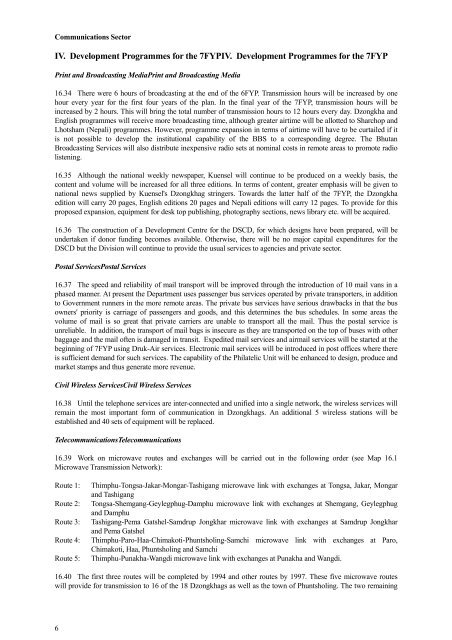COUNTRY BACKGROUND - Gross National Happiness Commission
COUNTRY BACKGROUND - Gross National Happiness Commission
COUNTRY BACKGROUND - Gross National Happiness Commission
You also want an ePaper? Increase the reach of your titles
YUMPU automatically turns print PDFs into web optimized ePapers that Google loves.
Communications Sector<br />
IV. Development Programmes for the 7FYPIV. Development Programmes for the 7FYP<br />
Print and Broadcasting MediaPrint and Broadcasting Media<br />
16.34 There were 6 hours of broadcasting at the end of the 6FYP. Transmission hours will be increased by one<br />
hour every year for the first four years of the plan. In the final year of the 7FYP, transmission hours will be<br />
increased by 2 hours. This will bring the total number of transmission hours to 12 hours every day. Dzongkha and<br />
English programmes will receive more broadcasting time, although greater airtime will be allotted to Sharchop and<br />
Lhotsham (Nepali) programmes. However, programme expansion in terms of airtime will have to be curtailed if it<br />
is not possible to develop the institutional capability of the BBS to a corresponding degree. The Bhutan<br />
Broadcasting Services will also distribute inexpensive radio sets at nominal costs in remote areas to promote radio<br />
listening.<br />
16.35 Although the national weekly newspaper, Kuensel will continue to be produced on a weekly basis, the<br />
content and volume will be increased for all three editions. In terms of content, greater emphasis will be given to<br />
national news supplied by Kuensel's Dzongkhag stringers. Towards the latter half of the 7FYP, the Dzongkha<br />
edition will carry 20 pages, English editions 20 pages and Nepali editions will carry 12 pages. To provide for this<br />
proposed expansion, equipment for desk top publishing, photography sections, news library etc. will be acquired.<br />
16.36 The construction of a Development Centre for the DSCD, for which designs have been prepared, will be<br />
undertaken if donor funding becomes available. Otherwise, there will be no major capital expenditures for the<br />
DSCD but the Division will continue to provide the usual services to agencies and private sector.<br />
Postal ServicesPostal Services<br />
16.37 The speed and reliability of mail transport will be improved through the introduction of 10 mail vans in a<br />
phased manner. At present the Department uses passenger bus services operated by private transporters, in addition<br />
to Government runners in the more remote areas. The private bus services have serious drawbacks in that the bus<br />
owners' priority is carriage of passengers and goods, and this determines the bus schedules. In some areas the<br />
volume of mail is so great that private carriers are unable to transport all the mail. Thus the postal service is<br />
unreliable. In addition, the transport of mail bags is insecure as they are transported on the top of buses with other<br />
baggage and the mail often is damaged in transit. Expedited mail services and airmail services will be started at the<br />
beginning of 7FYP using Druk-Air services. Electronic mail services will be introduced in post offices where there<br />
is sufficient demand for such services. The capability of the Philatelic Unit will be enhanced to design, produce and<br />
market stamps and thus generate more revenue.<br />
Civil Wireless ServicesCivil Wireless Services<br />
16.38 Until the telephone services are inter-connected and unified into a single network, the wireless services will<br />
remain the most important form of communication in Dzongkhags. An additional 5 wireless stations will be<br />
established and 40 sets of equipment will be replaced.<br />
TelecommunicationsTelecommunications<br />
16.39 Work on microwave routes and exchanges will be carried out in the following order (see Map 16.1<br />
Microwave Transmission Network):<br />
Route 1: Thimphu-Tongsa-Jakar-Mongar-Tashigang microwave link with exchanges at Tongsa, Jakar, Mongar<br />
and Tashigang<br />
Route 2: Tongsa-Shemgang-Geylegphug-Damphu microwave link with exchanges at Shemgang, Geylegphug<br />
and Damphu<br />
Route 3: Tashigang-Pema Gatshel-Samdrup Jongkhar microwave link with exchanges at Samdrup Jongkhar<br />
and Pema Gatshel<br />
Route 4: Thimphu-Paro-Haa-Chimakoti-Phuntsholing-Samchi microwave link with exchanges at Paro,<br />
Chimakoti, Haa, Phuntsholing and Samchi<br />
Route 5: Thimphu-Punakha-Wangdi microwave link with exchanges at Punakha and Wangdi.<br />
16.40 The first three routes will be completed by 1994 and other routes by 1997. These five microwave routes<br />
will provide for transmission to 16 of the 18 Dzongkhags as well as the town of Phuntsholing. The two remaining<br />
6

















